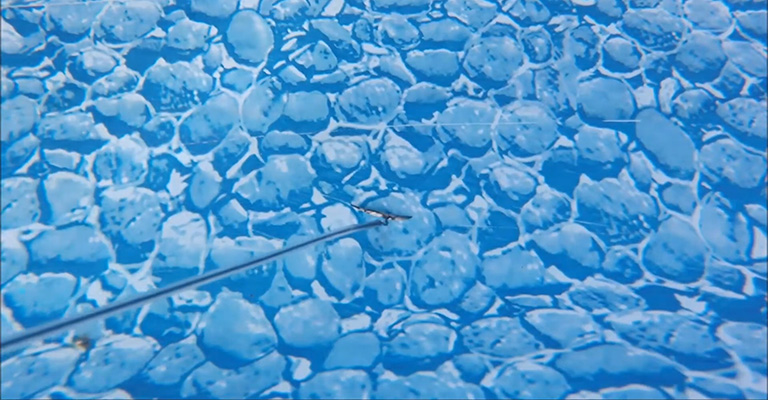The water in your pool will naturally evaporate, splash out, and be absorbed by the backwash wastewater. In addition to receiving water from rainfall, you will also be able to store it.
A general rule of thumb is that if you consistently add more than two inches of water to your pool a week, there may be a leak worth repairing.
You’re losing a lot of water, but do you know how much? Make sure that water levels are marked with tape or a pencil. There is a reason why pools need to be watertight.
While sealants degrade over time, other parts of your pool shift and settle, or old parts simply wear out. In addition to fittings, accessories, plumbing, and equipment, pools can leak through the shell.
A leak must be repaired to save water, heat, and chemicals and prevent undermining pool structural components and wash away fill dirt that supports the pool walls. Do you know how to find a leak in a swimming pool?
The water you lose to evaporation in your pool, splashing out and backwashing your filter, is natural. However, if you find that you are routinely adding more than two inches of water to your pool every week, you might have a leak.
Right, huh? That’s not so fast. Consider whether you can fix the problem before calling the local pool technician.
How Can You Tell Where Your Pool is Leaking?
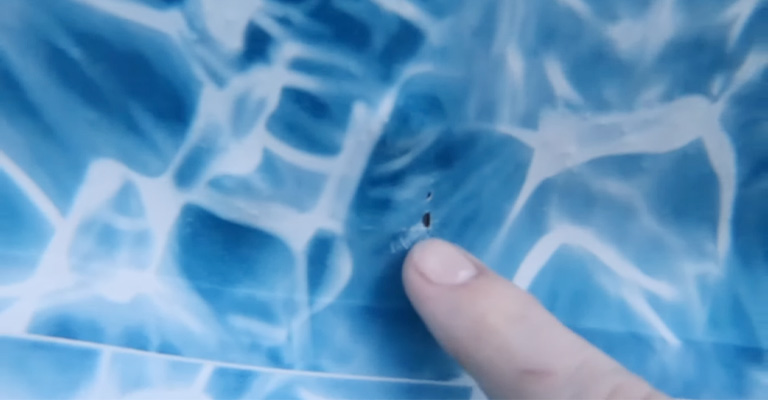
To determine where the leak is occurring, make sure the leak isn’t inside your plumbing or pool equipment before running any tests.
Make sure you check every area of the filter system. Included in this are your pool pump, filter, heater, chlorinator, and any O-rings or connections where water may be leaking. It is a good thing that these leaks are easy to locate.
If there is a leak in a part of your plumbing you can’t see, there is a possibility that you might not be able to detect it. Leaks can also occur underground in cracked piping if you have an inground pool.
However, if you aren’t sure whether you have a plumbing leak, you should first check if you’re losing water to evaporation in your pool.
Common Signs Of A Leaking Pool
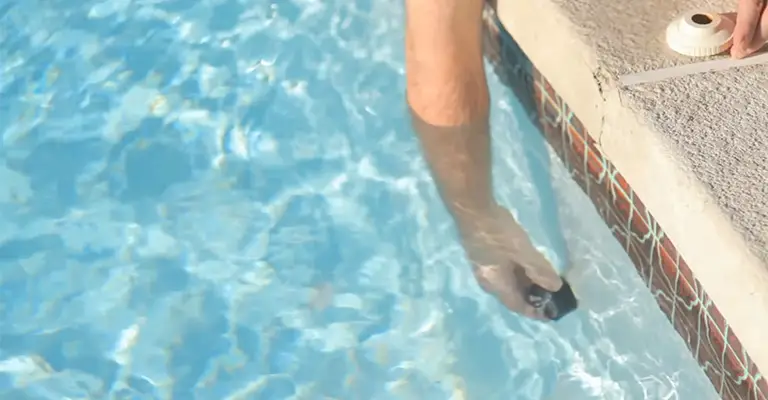
Leaking pools cause water loss as one of their apparent symptoms, but what are the other signs of a leak?
Being alert to these signs can allow you to prevent further damage, putting you in the position to handle the situation as a hero.
Water Level Changes
The most obvious sign that a pool is leaking is a drop in water level. However, it is important to determine if the loss is due to evaporation or a leak.
Several factors affect evaporation rates, including wind, air and water temperature, humidity, and many others.
Check out our Evaporation Calculator to see the evaporation rate in your area based on current weather data. When the pool loses more water than that, it is likely leaking.
Air or Dirt Blown Into Pool
The returns may be blowing air or dirt into the pool if air or dirt is being drawn into the plumbing system through a leak. There may be mysterious sounds associated with this as well.
Algae Growth
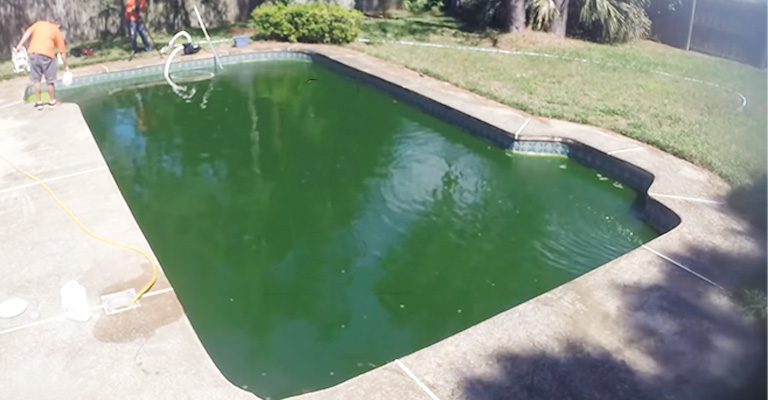
A leaky pool’s continuous addition of new, untreated water often results in fluctuating chemical consumption and algae growth. You may be able to find and fix a leak rather than continuing to treat the water.
Water Under Equipment
There is no doubt a leak when there is standing water or corrosion around the pump or pipes. Visual inspection is often sufficient for finding equipment leaks.
High Water Bills
Filtering devices that keep pools filled can conceal leaks. When you notice the autofill running constantly or have increased water bills, it might be time to investigate.
Wet Spots in Yard
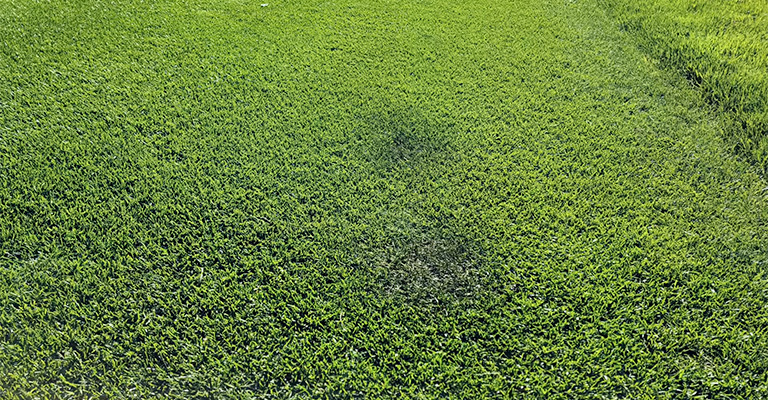
The plumbing may leak, and soft, mushy spots may appear around the pool area. In some cases, landscaping can shift and sink due to erosion caused by underground water movement.
Cracks or Falling Tile
The presence of excess water causes the ground to shift, causing cracks and tile movement. With the pool sinking further into the softened ground, damages may occur in the bond beam.
Does Your Pool Have a Leak, or Is it Evaporation?
The first step to pool leak detection is determining whether you are losing water to evaporation. In this way, you will be able to pinpoint where the leak originates. Using the bucket test or ink test can help you determine this.
Pool Leak Detection: Dye Test
The next method helps you pinpoint exactly where the leak is located, although it is more complicated.
Adding a leak finder dye directly to your pool water will solve this problem. Mark potential leaky spots in your pool using waterproof tape if you have any on hand.
1. Check the Ground and Walls Around the Pool for Wetness. There is most likely a leak from your pool somewhere near the area where the ground becomes wet, along with some ground seeping. Before using the leak finder dye, try narrowing it down as much as possible.
2. Turn Off the Pump and Water Features. If you want to find the leak, you should keep the water as still as possible before using the dye. As a result, you can also detect leaks in the skimmer or close by.
3. Use the Pool Leak Detection Dye to Pinpoint the Leak. You should go to the edge of the swimming pool where you think the leak might be.
Squirt the dye close to the surface and the wall of the water without touching it. The dye will move towards the leak’s location if it’s close to it, like a current if the leak is close.
4. Mark the Spot for Patching. You should mark the area where you saw the leak detection dye moving toward with waterproof tape. To ensure you do not forget where to patch the leak, write down the location.
You can use the leak finder to determine if your leak is located at the bottom of your pool if you have goggles and swim to the bottom. When you do the test, you must be as still as possible to prevent the dye from dripping everywhere.
Pool Leak Detection: Bucket Test
DIY is simple, and you probably have all the supplies you need:
- 5-gallon plastic bucket
- Waterproof marker or duct tape
1. Place and Fill the Bucket. On the second step of your pool, put your empty 5-gallon bucket in the water. You should fill the bucket to match the water level in the pool. Within the bucket, mark this level using a marker or duct tape.
2. Turn Off the Pump. Disconnect the recirculating pump and any other automatic refill device you may have.
3. Compare Water Levels. You should compare the pool water level and the bucket water level after 24 hours. Your pool is losing water due to evaporation if both the pool and bucket still have the same amount of water. The swimming pool level is likely to be lower than the bucket level if the level is now lower.
4. Repeat with Pump On. Reproduce the test for another 24 hours, this time with the pump on, in order to narrow down the possible source of the leak.
5. Compare New Results. Generally, a leak in your pool’s filter system or plumbing will cause the most significant water loss when under pressure.
Is The Pool Leaking Only With The Equipment On?
It may be that a pressure-side return leak is present when you detect a pool leak while the pump is running. After the filter pump has been switched on, the plumbing on the pressure side (after the pump) is under pressure.
It can open up small drips into large gushers. The waste or backwash line should run consistently. There are 500 gallons of water lost per inch of pool water!
Check downward from the pool for weepers to determine if underground leaks are coming to the surface. Check for soft or wet spots if the water from the swimming pool returns to the yard.
Is The Pool Leaking Only With The Equipment Off?
A suction-side leak usually occurs when the pump stops running, involving the pipes that carry water from the pool to the pump.
When the filter pump is turned on, the suction side plumbing is under vacuum. By drawing air into otherwise leaky voids, you can increase the amount of moisture in your home.
A transparent lid on your pump basket (if you have one) may indicate air pressure inside, bubbles coming from the return lines, or air continually building up inside the filter tank.
Are There Leaks At The Equipment Pad?
You should examine the filter, pump, heater, and valves closely. You can check the ground for moisture by looking at it.
When you turn off the pump, look closely for a spray of water coming out of it. It will not be a small drip or two that causes the primary leak. Loss of water level will be noticeable in the pool, but it won’t be a drip, but a trickle, at least.
Underground Pipe Leaks
Using sensitive equipment, leak detectors can locate leaks in underground pipework that may have been damaged by tree roots or shifting ground, separating or cracking pipework, and restore the leak with minimal intrusion in your outdoor living space.
When To Ask a Professional to Test and Repair a Pool Leak
Detecting leaks in pools can cost several hundred dollars. While some pool companies might include minor patch jobs in their prices, for any pool owner, it would be worth trying some of these methods before hiring a professional.
Homeowners who have an inground pool and suspect the leak is underground should contact a pool professional to pressure test the lines.
Consider consulting a pro if swimming pool leak detection or any other pool repair becomes too difficult or you’re not sure you’re getting the best results.
Final Words
If left unattended, leaks in a pool can result in sinkholes, most significant pool damage, and foundation shifts. Additionally, the cost of replacing water every day from a persistent leak drains your wallet.
Pool technicians know how to find leaks in pools and ensure that the next pool party is held at any time. Although homeowners can attempt to detect leaks themselves, they will definitely be able to find a leak in a pool and schedule the next party.

